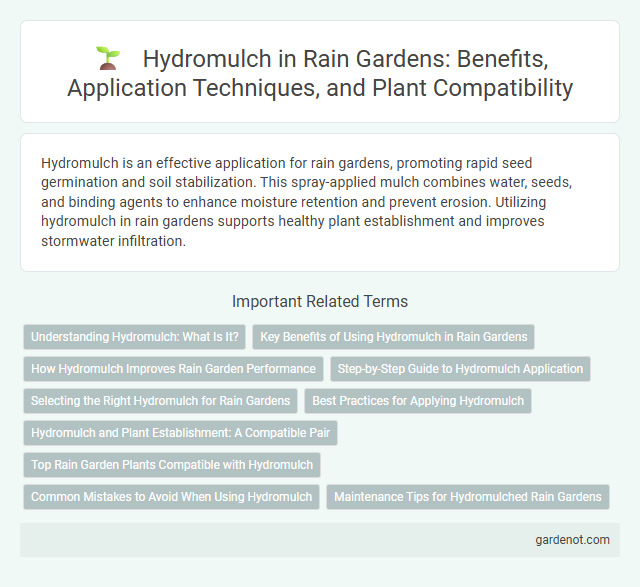Hydromulch is an effective application for rain gardens, promoting rapid seed germination and soil stabilization. This spray-applied mulch combines water, seeds, and binding agents to enhance moisture retention and prevent erosion. Utilizing hydromulch in rain gardens supports healthy plant establishment and improves stormwater infiltration.
Understanding Hydromulch: What Is It?
Hydromulch is a spray-applied mixture of water, mulch fibers, seed, fertilizer, and binding agents designed to promote rapid vegetation establishment in rain gardens. This method enhances soil erosion control and moisture retention, creating an ideal environment for native plants to thrive. Hydromulch forms a protective layer that helps stabilize soil and supports sustainable stormwater management.
Key Benefits of Using Hydromulch in Rain Gardens
Hydromulch in rain gardens promotes rapid seed germination and soil stabilization by providing a protective, moisture-retentive layer that enhances water absorption and reduces erosion. This biodegradable mixture of water, seed, mulch, and binder supports healthy plant growth while minimizing sediment runoff into stormwater systems. Its application improves rain garden efficiency in managing stormwater, filtering pollutants, and sustaining diverse vegetation.
How Hydromulch Improves Rain Garden Performance
Hydromulch enhances rain garden performance by stabilizing soil and reducing erosion through a protective layer of mulch slurry that retains moisture and promotes healthy vegetation growth. Its application accelerates seed germination and root establishment, essential for filtering pollutants and managing stormwater runoff effectively. The moisture-retentive properties of hydromulch also improve soil structure, supporting diverse plant species that increase the rain garden's capacity to mitigate flooding and enhance water quality.
Step-by-Step Guide to Hydromulch Application
Hydromulch application in rain gardens begins with surface preparation by removing debris and loosening soil to enhance seed-to-soil contact. The hydromulch mixture, typically comprising seed, mulch fibers, fertilizer, and water, is blended uniformly in a hydroseeder to ensure even distribution. Apply the hydromulch evenly over the prepared area, maintaining a consistent thickness to promote moisture retention and prevent erosion, crucial for establishing healthy rain garden vegetation.
Selecting the Right Hydromulch for Rain Gardens
Selecting the right hydromulch for rain gardens involves choosing a blend that promotes rapid seed germination, soil stabilization, and moisture retention to withstand heavy rainfall. Hydromulch mixtures with organic fibers like wood cellulose combined with tackifiers enhance erosion control and nutrient delivery, supporting robust plant growth in diverse soil types. Opting for biodegradable, environmentally friendly hydromulch ensures long-term sustainability and minimizes negative impacts on local water quality in rain garden applications.
Best Practices for Applying Hydromulch
Applying hydromulch in rain gardens requires even distribution of the slurry mixture to ensure uniform seed coverage and soil stabilization. Optimal application rates range from 1,500 to 3,000 pounds per acre, balancing moisture retention with seed germination needs. Using a specialized hydromulching machine improves adhesion and prevents erosion on sloped garden surfaces, enhancing plant establishment.
Hydromulch and Plant Establishment: A Compatible Pair
Hydromulch enhances plant establishment in rain gardens by promoting soil moisture retention and reducing erosion, creating an optimal environment for seed germination and root development. Its biodegradable composition supplies essential nutrients while maintaining soil structure, which supports healthier plant growth and quicker stabilization. This synergy between hydromulch and plant establishment ensures effective rain garden performance in stormwater management.
Top Rain Garden Plants Compatible with Hydromulch
Top rain garden plants compatible with hydromulch include native species like switchgrass (Panicum virgatum), blue flag iris (Iris versicolor), and swamp milkweed (Asclepias incarnata) which thrive in moist, well-drained soils. Hydromulch promotes rapid seed germination and soil stabilization, making it ideal for these species that require consistent moisture during establishment. Choosing hydromulch-friendly plants enhances erosion control and supports local biodiversity in rain garden ecosystems.
Common Mistakes to Avoid When Using Hydromulch
Applying hydromulch without proper surface preparation can lead to poor seed-to-soil contact, reducing the effectiveness of seed germination in rain gardens. Over-application of hydromulch increases costs and may hinder water infiltration, impacting the garden's ability to manage runoff efficiently. Neglecting to adjust mulch type or application rates for rain garden slopes can cause erosion and uneven coverage, compromising plant establishment and stormwater management.
Maintenance Tips for Hydromulched Rain Gardens
Regular watering is essential during the initial establishment phase of hydromulched rain gardens to promote seed germination and root development. Inspect the mulch layer frequently to ensure it remains intact and reapply as needed to prevent erosion and maintain soil moisture. Remove invasive weeds promptly to reduce competition and enhance the growth of native plants within the hydromulched area.
Hydromulch Infographic

 gardenot.com
gardenot.com